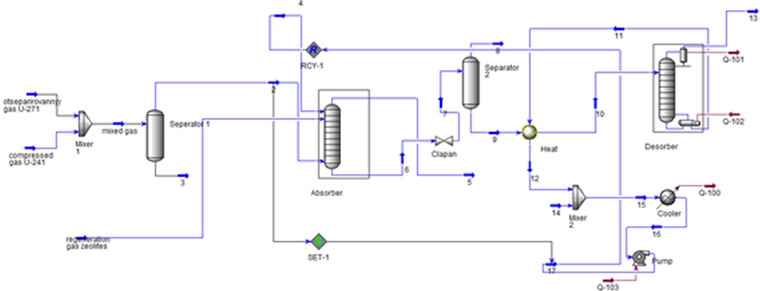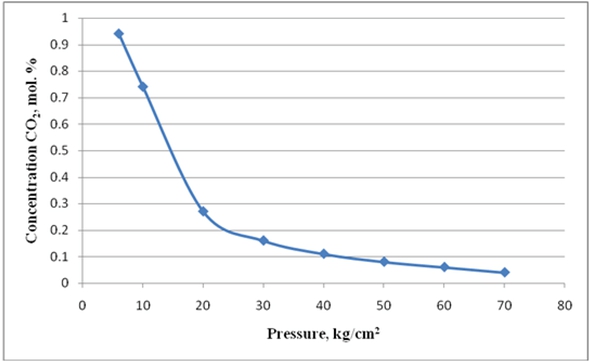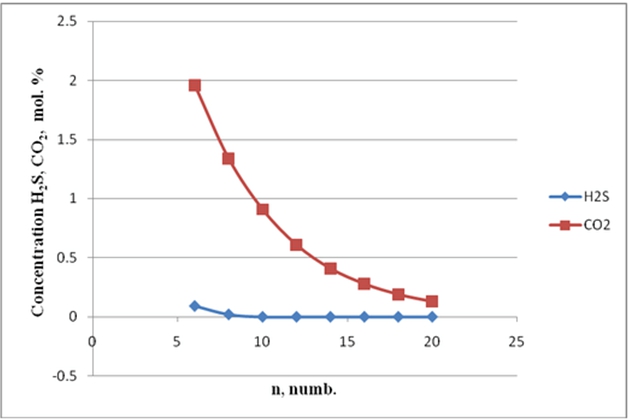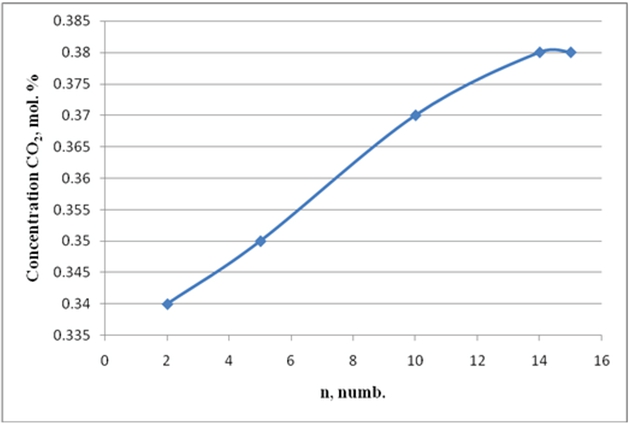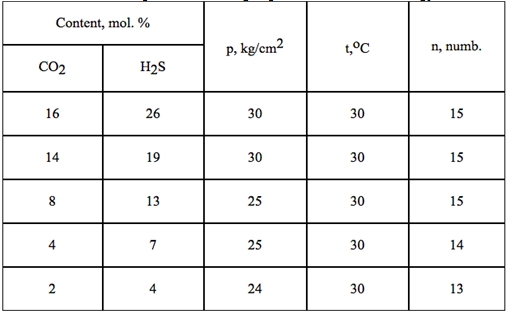ОЧИСТКА ПРИРОДНОГО ГАЗА - ОПРЕДЕЛЕНИЕ РАЦИОНАЛЬНОЙ ТЕХНОЛОГИИ И СОЗДАНИЕ МОДЕЛИ ТЕХНОЛОГИЧЕСКОЙ СХЕМЫ ПРОЦЕССА
Шариков Ю.В. 1, Ткачев И.В. 2
1Профессор, доктор технических наук,
2студент,
Национальный минерально-сырьевой университет «горный» (Горный университет)
ОЧИСТКА ПРИРОДНОГО ГАЗА - ОПРЕДЕЛЕНИЕ РАЦИОНАЛЬНОЙ ТЕХНОЛОГИИ И СОЗДАНИЕ МОДЕЛИ ТЕХНОЛОГИЧЕСКОЙ СХЕМЫ ПРОЦЕССА
Аннотация
В статье рассматривается опыт применения технологии очистки природного газа диэтаноламином для изучения эффективности процесса абсорбции, имеющего широкое практическое применение. Была исследована рациональность применения метода очистки газа для решения задач определения оптимальных условий при различном составе исходного газа.
Ключевые слова: природный газ, очистка, технология, моделирование.
Sharikov I.V. 1, Tkachev I.V.2
1Professor, Dr. of Science (Chem. Engng.),
2student,
National mineral resources university (Mining university)
NATURAL GAS PURIFIFICATION – DEFINITION OF RATIONAL TECHNOLOGY AND CREATION OF A MODEL OF TECHNOLOGICAL SCHEME OF THE PROCESS
Abstract
The article discusses the experience of treatment technology of natural gas diethanolamine to study the effectiveness of the absorption process, which has wide practical application. We investigated the rationality of the method of gas purification for solutions of the problem of determining the optimum conditions for the different composition of the initial gas.
Keywords: natural gas, purification, technology, modeling.
Introduction
The basis of the universal system HYSYS simulation calculations laid down the general principles of the material - heat balances flowsheets. In general, simulation flowsheet based on the application of these general principles of thermodynamics to the individual circuit elements and the system as a whole.
When creating complex software in HYSYS model gas purification plant of hydrogen sulfide, carbon dioxide and sulfur impurities amine solution. Determined by the input flow conditions of the gas and sorbent, such as temperature, pressure, flow rate and number of plates for the effective absorption of the process given in the column varying concentrations of noxious gas impurities.
Therefore, the determination of optimal input thermodynamic parameters depending on the content of harmful impurities of natural gas, as well as the calculation of the rational use of sorbent in the purification process is an actual scientific and applied problems the solution of which will significantly improve technical and economic performance of the purification process gas from hydrogen sulfide and carbon dioxide. Determination of rational technology of purification of natural gas from hydrogen sulfide and carbon dioxide, can improve product quality, increase the productivity of the plant.
Absorption of the reaction gas purification process are exothermic and reversible depending on the pressure temperature (through the gas-liquid equilibrium). Low temperature and high pressure hydrogen sulfide contribute to the absorption and carbon dioxide.
The main chemical reactions in the liquid phase are as follows:
Reaction with Н2S andСО2:
To diethanolamine (DEA)
The reaction of Н2S/amine runs instantly
R 2 NH + H2S R2 NH+2 HS-
The reaction CO2 with DEA, with formation of carbamate runs- quickly
СО2 + 2R2 NHR2 NCOO- R2NH+2
Absorption of carbon dioxide runs slowly
СО2 + H2O H2CO3
СО2 +ОН- HCO-3
Formation of carbonates and bicarbonates:run as follows:
2R2 NH + H2CO3 2(R2 NH+2 )CO3
2(R2 NH+2)CO--3 + H2CO3 2R2 NH+2HCO--3
where R represents a radical - СН2СН2ОН
Experimental results and discussion
Fig. 1 -Scheme model for purification of natural gas from hydrogen sulfide and carbon dioxide
With the help created scheme optimal thermodynamic parameters have been identified. Low temperature and high pressure contribute to the absorption of hydrogen sulfide and carbon dioxide, and the permissible range of temperatures in the HYSYS software package starts at 25 oC. Based on these conditions, the effective working temperature is assumed to be 30 oC. The pressure in the column is determined empirically depending on the purity of the product and the contents of harmful impurities in the feed of the column. The selection criterion values determined molar concentrations of carbon dioxide and hydrogen sulfide in the product of 0.02% and 0%, respectively.
Fig. 2 - Dependence of the contents of harmful impurities in the product of the pressure in the column
Graph shown in figure 2 describes the dependence of the carbon dioxide content on the pressure in the absorber at the minimum acceptable number of plates (equal to 10) required for effective process of absorption in the absence of hydrogen sulfide in the output product of the installation.
The number of trays of the absorption column and the feed point of the input power as the influence on the thermodynamic parameters and the degree of purification of the product, however they also have been determined experimentally. The sample values produced by the previously mentioned criteria.
Fig. 3 - Dependence of harmful impurities in the product on the number of plates
Graph in figure 3 shows the curves of concentration of hydrogen sulfide and carbon dioxide in the product of the absorption column, at the lowest possible pressure column equal 6 kg/cm2.
Fig. 4 - Dependence of product quality upon the point of input power
Representation of the relationship in figure 4 shows the qualitative characteristics of the product from the point of power entry. Number plates absorber is 15 - the optimum number for effective purification, the minimum pressure of the absorber is 6 kg/cm2 for uncomplicated possibilities depending demonstration. The most effective option feed is performed to the plate number 2.
Gases entering the treatment plant alkanolamines have different contents of hydrogen sulfide, carbon dioxide and sulfur impurities is therefore appropriate to use different modes of operation of the absorption column, derived experimentally and shown in Table 1. The range of values of the contents of harmful impurities was taken from the gas condensate deposits existing as such Astrakhan gas condensate field containing hydrogen sulfide and carbon dioxide, shown in the table as the maximum and the Karachaganak oil and gas field - the minimum value in Table 1.
Table 4 - Optimal values gas purification technology
n – the number of trays in the absorber
t – temperature in the absorber
p – pressure in the absorber
The Table 1 shows the conditions of the process of absorption of hydrogen sulfide at various concentrations of carbon dioxide in the feed. The criterion for selection of optimum conditions is the degree of purity of the product, namely the molar concentration of carbon dioxide and hydrogen sulfide in the finished product is 0.02% and 0%, respectively.
Conclusion
The created model gas purification scheme to determine the optimal parameters of the technological scheme of purification plant natural gas from hydrogen sulfide and carbon dioxide at a different content of harmful impurities in the incoming gas installation. This solves the technical - economic challenges facing installation using software package HYSYS.
References
- Basniev K. S. Jenciklopedija gazovoj promyshlenosti. 4-e izdanie – 1994. – 900 s.
- Metodicheskoe posobie po programme podgotovki studentov tehnologicheskih disciplin. Rabota v srede «HYSYS» [Jelektronnyj resurs] URL: http://tpv-ugntu.narod.ru/HYSYS_1.pdf (data obrashhenija 20.12.2014).

